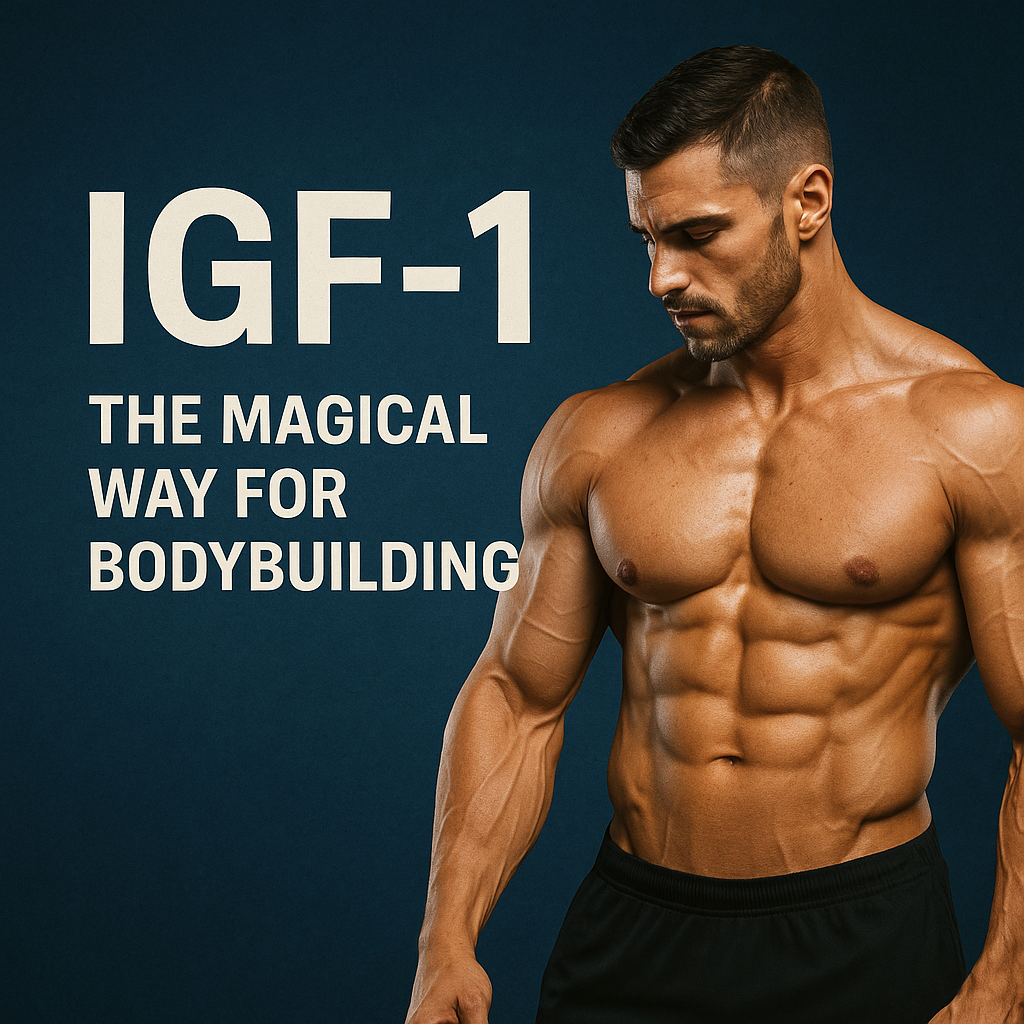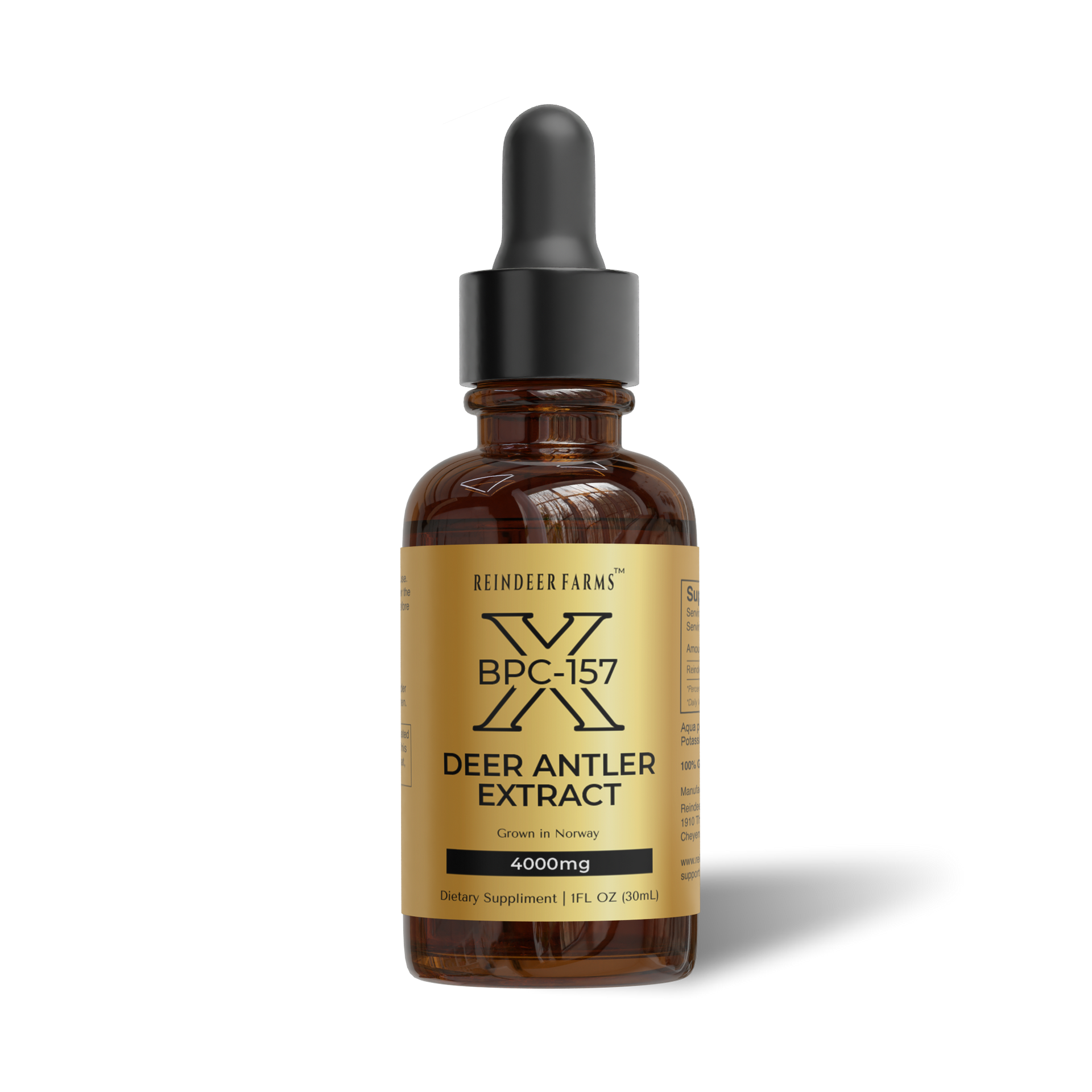
In the competitive world of bodybuilding, athletes constantly search for effective methods to enhance muscle growth, improve recovery, and optimize performance. Insulin-like Growth Factor 1 (IGF-1) has received attention in fitness communities for its role in muscle development. This comprehensive guide explores IGF-1's definition, classification, mechanisms, potential benefits and risks, and evidence-based natural methods to support healthy IGF-1 levels, providing you with balanced information to make informed decisions about your training approach.
What is IGF-1?
IGF-1 (Insulin-like Growth Factor 1) is a polypeptide hormone structurally similar to insulin that functions as the primary mediator of human growth hormone (HGH) effects. Produced predominantly in the liver in response to growth hormone stimulation, IGF-1 plays a fundamental role in cellular growth, differentiation, and metabolism throughout the body.
In the context of muscle development, IGF-1 is particularly significant. When growth hormone is released from the pituitary gland, it stimulates the liver to produce IGF-1, which then circulates in the bloodstream and binds to specific receptors on muscle cells. This binding initiates a cascade of cellular events that promote protein synthesis, inhibit protein breakdown, and facilitate glucose uptake by muscles—all essential processes for muscle hypertrophy (growth).
Unlike insulin, which primarily regulates blood glucose levels, IGF-1 coordinates complex growth processes across multiple tissues, making it an important regulator of growth and regeneration in the human body. This multifaceted role has made IGF-1 a subject of scientific interest for understanding muscle development.
Classification of IGF-1 and Its Variants
Natural IGF-1
Endogenous (naturally occurring) IGF-1 is primarily synthesized in the liver following growth hormone stimulation. This systemic IGF-1 circulates through the bloodstream bound to specific carrier proteins, which regulate its bioavailability and half-life. However, many tissues, including muscle, also produce IGF-1 locally, creating an autocrine/paracrine system that supplements the endocrine effects of liver-derived IGF-1.
The locally produced IGF-1 in muscle tissue, often referred to as mechano growth factor (MGF), is particularly responsive to mechanical stimulation through resistance training. This localized production creates a targeted anabolic environment specifically within the trained muscles, contributing significantly to exercise-induced muscle hypertrophy.
Pharmaceutical IGF-1 Variants and Their Regulatory Status
IGF-1 LR3 (Long R3 IGF-1): This modified form contains 83 amino acids, including a substitution where arginine replaces glutamic acid at position 3 and an extension of 13 amino acids at the N-terminus. These modifications significantly increase its potency and extend its half-life compared to natural IGF-1.
DES IGF-1: A truncated variant missing the first three amino acids, which exhibits greater potency than natural IGF-1 due to reduced binding to IGF binding proteins.
Mecasermin: A pharmaceutical-grade recombinant human IGF-1 used medically to treat growth failure in children with severe IGF-1 deficiency. This is an FDA-approved medication for specific medical conditions only.
How Does IGF-1 Work in Muscle Development?
Muscle Growth Mechanism
IGF-1 influences muscle growth through several interconnected pathways:
mTOR Activation: IGF-1 binding to its receptor activates the mammalian target of rapamycin (mTOR) signaling pathway, which serves as a master regulator of protein synthesis. Research published in the Journal of Applied Physiology demonstrates that mTOR activation increases the rate of muscle protein synthesis, a fundamental process for hypertrophy (Bodine et al., 2001).
Satellite Cell Activation: IGF-1 stimulates muscle stem cells (satellite cells) to proliferate and differentiate. These activated satellite cells donate their nuclei to existing muscle fibers, increasing the fiber's capacity for protein synthesis. A study in the Journal of Physiology found that IGF-1 can influence satellite cell activation in muscle tissue (Chakravarthy et al., 2000).
Anti-Catabolic Effects: Beyond promoting protein synthesis, IGF-1 can inhibit protein breakdown pathways, particularly through suppression of FoxO transcription factors that would otherwise activate proteolytic systems. This dual action of increasing synthesis while decreasing breakdown can create an environment favorable to muscle development.
Research Note: While some animal studies have suggested IGF-1 may promote muscle fiber hyperplasia (an increase in the number of muscle fibers), this effect remains controversial in humans and the current scientific consensus does not support this as a significant mechanism in human muscle development.
Fat Metabolism Influence
IGF-1 may contribute to body composition through several mechanisms:
IGF-1 participates in metabolic processes related to lipolysis (the breakdown of fat) and glucose metabolism. Research suggests IGF-1 may influence how the body directs nutrients, though the magnitude of these effects under normal physiological conditions is modest (Mauras et al., 2000).
It's important to note that these metabolic effects are part of normal physiology and should not be interpreted as a weight loss mechanism. Changes in body composition are primarily achieved through proper nutrition and exercise protocols.
Recovery and Tissue Response
One aspect of IGF-1's physiological role involves tissue response:
IGF-1 participates in the body's normal recovery processes as part of the natural inflammatory and regenerative response. Research in the Journal of Applied Physiology has observed that local IGF-1 production increases at sites of muscle activity, as part of the body's normal adaptive response (Bamman et al., 2001).
For athletes, understanding these natural processes can help inform recovery strategies that support the body's natural mechanisms. However, the relationship between IGF-1 and recovery is complex and involves many other physiological factors.
Potential Benefits and Risks
Scientific Research on IGF-1 and Muscle Development
Research has investigated the relationship between IGF-1 and resistance training responses:
Muscle Protein Synthesis: Studies have observed relationships between IGF-1 signaling and muscle protein synthesis responses following resistance training. Research published in the Journal of Strength and Conditioning Research found correlations between natural IGF-1 levels and muscular adaptations, though many factors influence these outcomes (West & Phillips, 2012).
Recovery Processes: IGF-1 is among many factors involved in the body's recovery processes. A study in the European Journal of Applied Physiology observed relationships between hormonal factors including IGF-1 and markers of recovery following training (Kraemer et al., 2009).
Performance Capacity: Some research has investigated connections between natural hormonal profiles and performance metrics, though these relationships are complex and influenced by numerous factors including training status, nutrition, genetics, and other variables (Frystyk, 2010).
Connective Tissue Response: IGF-1 is among many growth factors that participate in connective tissue responses to training. Research in the Journal of Orthopedic Research suggests various growth factors including IGF-1 may be involved in collagen synthesis and tissue remodeling after exercise (Heinemeier et al., 2012).
Important Health Considerations and Risks
The following information applies specifically to pharmaceutical IGF-1 compounds, not natural IGF-1 production:
Potential Health Risks:
- Cancer Risk: IGF-1 stimulates cell growth and proliferation, which has raised concerns about potential increased cancer risk with elevated IGF-1 levels, particularly with long-term pharmaceutical use.
- Hypoglycemia: IGF-1 can cause dangerous drops in blood sugar levels, potentially leading to serious or life-threatening hypoglycemic events.
- Acromegaly-Like Symptoms: Long-term elevated IGF-1 levels can cause tissue and organ growth, including enlargement of facial features, hands, feet, and internal organs.
- Cardiovascular Concerns: Changes to heart function and structure have been associated with altered IGF-1 levels.
- Hormonal Imbalances: Disruption of the body's natural hormonal balance can cause widespread effects throughout multiple body systems.
This is not a comprehensive list of all possible risks and side effects. Any pharmaceutical use of IGF-1 requires medical supervision and monitoring for potential adverse effects.
Evidence-Based Natural Approaches to Support Healthy IGF-1 Levels
Exercise Strategies
Specific training approaches can influence the body's natural hormonal responses:
Resistance Training Protocols: Research published in the Journal of Applied Physiology demonstrates that resistance training with intensities above 75% of one-repetition maximum (1RM) can stimulate acute increases in various hormonal factors including IGF-1 production (Kraemer et al., 2017). Training protocols involving compound movements with moderate-to-heavy weights and appropriate volume can be part of a comprehensive training approach.
Balanced Training Volume: While challenging training sessions can stimulate growth factor responses, excessive volume without adequate recovery may elevate stress hormones like cortisol, which can influence other hormonal factors. Research suggests that well-structured training programs that include appropriate recovery periods provide the best environment for optimal physiological responses (Nindl et al., 2011).
Incorporating Varied Stimuli: Including different training modalities (strength, power, and endurance elements) within a well-designed program may provide more comprehensive physiological benefits than single-mode training. A study in the European Journal of Applied Physiology found that mixed-method training protocols produced favorable hormonal responses compared to more limited approaches (Goto et al., 2005).
Nutrition Approaches
Nutrition plays a fundamental role in supporting optimal physiological function:
Protein Intake and Quality: Consuming adequate protein (1.6-2.2g per kg of bodyweight) provides the necessary amino acids for muscle protein synthesis and overall physiological function. Research in the Journal of Nutrition demonstrates that complete protein sources (such as whey, eggs, lean meats, and plant protein combinations) support the body's needs for muscle maintenance and development (Anthony et al., 2007).
Balanced Energy Intake: Appropriate caloric intake relative to activity level is essential for hormonal health. Both severe caloric restriction and excessive consumption can negatively impact hormonal balance. Research suggests that moderate energy surpluses during building phases and modest deficits during cutting phases produce better results than extreme approaches.
Carbohydrate Strategies: Strategic carbohydrate intake around training periods can support performance and recovery. A study in the American Journal of Physiology found that appropriate carbohydrate intake in the post-workout window can support recovery processes following resistance exercise (Bird et al., 2006).
Micronutrient Adequacy: Several micronutrients support overall hormonal health. Zinc and magnesium are particularly important for general hormonal function, and deficiencies can impact various physiological processes. Research in the Journal of Clinical Endocrinology and Metabolism demonstrates that addressing nutritional deficiencies can support overall hormonal health in previously deficient individuals (Devine et al., 1998).
These nutritional strategies create a comprehensive approach to supporting the body's natural physiological processes.
Lifestyle Factors
Beyond training and nutrition, several lifestyle factors significantly influence overall hormonal health:
Sleep Optimization: Sleep quality and duration directly impact numerous hormonal processes, including growth hormone pulsatility, which subsequently affects overall recovery and adaptation. Research in the Journal of Clinical Endocrinology and Metabolism found that sleep restriction can influence various metabolic and hormonal parameters compared to adequate sleep periods (Spiegel et al., 2000). Prioritizing 7-9 hours of quality sleep creates the foundation for optimal recovery and physiological function.
Stress Management: Chronic elevation of stress hormones can influence numerous aspects of physiology. Research published in Psychoneuroendocrinology demonstrates that stress reduction techniques including meditation, deep breathing exercises, and regular leisure activities can support healthier hormonal profiles (Jin, 1992).
Recovery Prioritization: Systematic recovery practices including contrast therapy (alternating hot and cold exposure), appropriate soft tissue work, and scheduled deload periods allow the body's systems to operate optimally. A study in the Journal of Strength and Conditioning Research found that athletes implementing structured recovery protocols maintained better performance throughout intensive training periods compared to those without such strategies (Kraemer et al., 2010).
These lifestyle factors represent the foundation of physiological optimization for athletes seeking to maximize their natural potential.
Natural Dietary Supplements
Some dietary supplements have been studied for their potential effects on training adaptations, though it's important to note that these effects are generally modest compared to the fundamentals of training, nutrition, and recovery:
Protein Supplements: Whey, casein, and plant-based protein supplements can help athletes reach their daily protein targets when whole food intake is insufficient. These supplements provide amino acids that serve as building blocks for tissue recovery and development.
Creatine Monohydrate: Among the most researched supplements in sports nutrition, creatine has been shown to enhance high-intensity performance capacity and support training adaptations through improved cellular energetics.
Essential Amino Acids (EAAs): These fundamental protein components, particularly leucine, can support muscle protein synthesis when consumed around training sessions.
Traditional Supplements: Throughout history, various traditional supplements have been used by different cultures to support training and recovery. Among these, velvet antler extracts derived from deer species have historical use dating back centuries in traditional Eastern practices. Companies like Reindeer Farms specialize in ethically sourced supplements that follow traditional harvesting practices.
For those interested in this category of supplements, Reindeer Farms offers products that are harvested from free-range, grass-fed Norwegian reindeer during the natural antler shedding cycle. Their processing methods focus on preserving the natural growth factors and amino acid profiles found in the antler matrix. While research on these traditional supplements is still developing, some athletes incorporate them as part of their comprehensive approach to recovery support.

It's worth noting that antler-based supplements contain various bioactive compounds including collagen, glycosaminoglycans, and trace minerals that support connective tissue health. Reindeer Farms processes the antler extracts using the latest technologies designed to maintain the natural compound structure, resulting in products like their Elite and Premium extracts that preserve the natural nutrient profile.
When considering any supplement, look for products that have been third-party tested for purity and quality, and always consult with a healthcare provider before beginning any supplement regimen, especially if you have underlying health conditions or take medications.
Conclusion
IGF-1 represents one factor among many in the complex processes of muscle development and recovery. Understanding the science behind physiological processes can help inform evidence-based approaches to training and nutrition.
The most sustainable and health-supporting approach for natural athletes involves optimizing training, nutrition, recovery, and lifestyle factors that support the body's natural processes. This approach balances performance goals with long-term health considerations, creating a foundation for continued progress in physique development.
Each individual must determine their personal balance between performance goals and health priorities, ideally in consultation with qualified healthcare providers and evidence-based fitness professionals who can provide personalized guidance based on individual needs and circumstances.
References
Anthony, J.C., et al. (2007). "Leucine stimulates translation initiation in skeletal muscle of postabsorptive rats via a rapamycin-sensitive pathway." Journal of Nutrition, 137(6), 1574-1580.
Bamman, M.M., et al. (2001). "Mechanical load increases muscle IGF-I and androgen receptor mRNA concentrations in humans." American Journal of Physiology-Endocrinology and Metabolism, 280(3), E383-E390.
Bird, S.P., et al. (2006). "Liquid carbohydrate/essential amino acid ingestion during a short-term bout of resistance exercise suppresses myofibrillar protein degradation." Metabolism, 55(5), 570-577.
Bodine, S.C., et al. (2001). "Akt/mTOR pathway is a crucial regulator of skeletal muscle hypertrophy and can prevent muscle atrophy in vivo." Nature Cell Biology, 3(11), 1014-1019.
Chakravarthy, M.V., et al. (2000). "Insulin-like growth factor-I extends in vitro replicative life span of skeletal muscle satellite cells by enhancing G1/S cell cycle progression via the activation of phosphatidylinositol 3'-kinase/Akt signaling pathway." Journal of Biological Chemistry, 275(46), 35942-35952.
Devine, A., et al. (1998). "Effects of zinc and other nutritional factors on insulin-like growth factor I and insulin-like growth factor binding proteins in postmenopausal women." The American Journal of Clinical Nutrition, 68(1), 200-206.
Frystyk, J. (2010). "Exercise and the growth hormone-insulin-like growth factor axis." Medicine & Science in Sports & Exercise, 42(1), 58-66.
Giustina, A., & Veldhuis, J.D. (1998). "Pathophysiology of the neuroregulation of growth hormone secretion in experimental animals and the human." Endocrine Reviews, 19(6), 717-797.
Final Disclaimer: This article is intended solely for informational and educational purposes. It does not provide medical advice, and the information contained herein should not be used to diagnose, treat, or prevent any disease. Always consult with a qualified healthcare provider before making any changes to your health or fitness regimen.



Comments (0)
Back to News